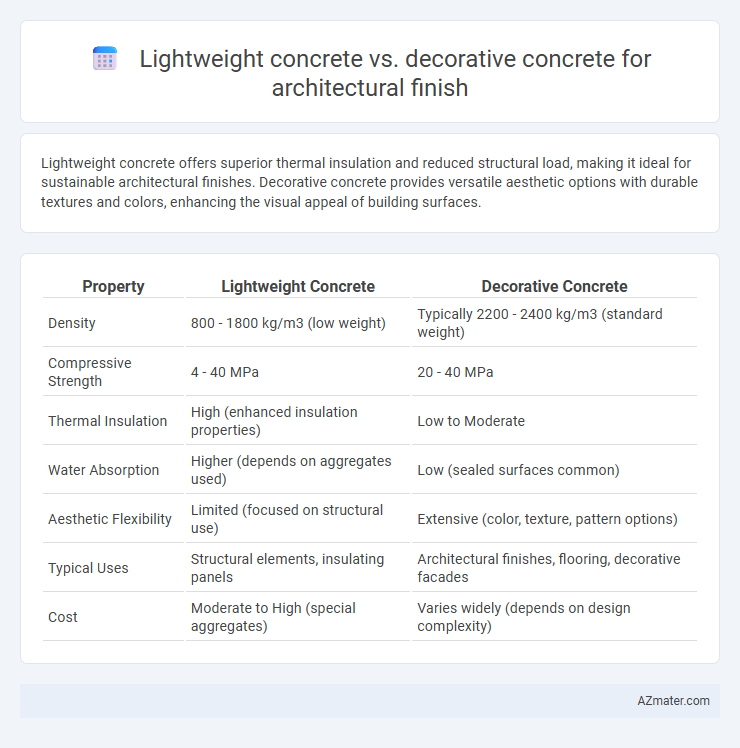Lightweight concrete offers superior thermal insulation and reduced structural load, making it ideal for sustainable architectural finishes. Decorative concrete provides versatile aesthetic options with durable textures and colors, enhancing the visual appeal of building surfaces.
Table of Comparison
| Property | Lightweight Concrete | Decorative Concrete |
|---|---|---|
| Density | 800 - 1800 kg/m3 (low weight) | Typically 2200 - 2400 kg/m3 (standard weight) |
| Compressive Strength | 4 - 40 MPa | 20 - 40 MPa |
| Thermal Insulation | High (enhanced insulation properties) | Low to Moderate |
| Water Absorption | Higher (depends on aggregates used) | Low (sealed surfaces common) |
| Aesthetic Flexibility | Limited (focused on structural use) | Extensive (color, texture, pattern options) |
| Typical Uses | Structural elements, insulating panels | Architectural finishes, flooring, decorative facades |
| Cost | Moderate to High (special aggregates) | Varies widely (depends on design complexity) |
Introduction to Lightweight and Decorative Concrete
Lightweight concrete is engineered by incorporating lightweight aggregates such as expanded clay or shale, resulting in reduced density and enhanced thermal insulation properties ideal for structural efficiency. Decorative concrete utilizes surface treatments, color additives, and stamping techniques to achieve aesthetic finishes that mimic natural stone, brick, or artistic patterns, enhancing architectural appeal. Both materials serve distinct roles in construction: lightweight concrete optimizes structural performance, while decorative concrete elevates visual impact.
Key Differences Between Lightweight and Decorative Concrete
Lightweight concrete features lower density due to aggregates like expanded clay or shale, providing better thermal insulation and reduced structural load, whereas decorative concrete prioritizes aesthetic appeal with various finishes, colors, and textures for architectural enhancement. Lightweight concrete is often used for structural elements requiring reduced weight, while decorative concrete serves surfaces where visual impact is key, such as flooring, facades, and countertops. The key difference lies in their primary functions: lightweight concrete focuses on performance and durability, decorative concrete emphasizes design versatility and surface customization.
Composition and Material Properties
Lightweight concrete incorporates lightweight aggregates such as expanded clay, shale, or pumice, resulting in reduced density and enhanced thermal insulation, making it ideal for structural elements requiring lower dead loads. Decorative concrete uses standard or polymer-modified cement matrices combined with pigments, aggregates, and surface treatments to achieve aesthetic finishes like stamping, staining, or polishing, emphasizing visual appeal over structural performance. The material properties of lightweight concrete prioritize strength-to-weight ratio and thermal efficiency, while decorative concrete focuses on surface durability, color stability, and texture consistency for architectural finishes.
Aesthetic Possibilities and Surface Finishes
Lightweight concrete offers unique aesthetic possibilities with its ability to create textured, sculptural surfaces and smooth finishes while reducing structural load, ideal for intricate architectural designs. Decorative concrete provides diverse surface finishes including stamped patterns, exposed aggregates, and polished surfaces, enhancing visual appeal and mimicking natural materials like stone or wood. Both materials support customization through coloring, staining, and overlay techniques, but decorative concrete excels in offering a broader palette of design options for vibrant and detailed architectural finishes.
Structural Performance and Durability
Lightweight concrete offers superior structural performance due to its reduced density, resulting in lower dead loads and increased load-bearing capacity ideal for large-scale architectural elements. Decorative concrete emphasizes aesthetics with various finishes and textures but may require additional treatment to enhance durability under weathering and wear. While lightweight concrete provides better thermal insulation and resistance to cracking, decorative concrete often necessitates sealants to maintain its appearance and longevity in exposed architectural finishes.
Installation Methods and Construction Techniques
Lightweight concrete offers rapid installation through easy handling and reduced structural load, often utilizing precast panels or spray applications ideal for complex shapes and insulation. Decorative concrete relies on advanced finishing techniques such as stamping, staining, polishing, and overlays applied on-site to achieve aesthetic patterns, textures, and colors. Both materials require specific curing processes and surface preparations, with lightweight concrete emphasizing formwork and lift planning, while decorative concrete demands skilled artisanship for customization and durability.
Energy Efficiency and Sustainability
Lightweight concrete improves energy efficiency by providing superior thermal insulation due to its low density and high insulating properties, reducing heating and cooling costs in buildings. Decorative concrete, while primarily focused on aesthetic appeal, can enhance sustainability when combined with energy-efficient mixes and recycled materials, lowering environmental impact. Both materials contribute to sustainable architecture, but lightweight concrete offers more direct benefits in energy conservation and thermal performance.
Cost Comparison and Budget Considerations
Lightweight concrete generally offers cost savings due to reduced material weight leading to lower transportation and structural support expenses, making it ideal for budget-sensitive architectural projects. Decorative concrete typically incurs higher costs because of specialized finishes, pigments, and labor-intensive installation processes required to achieve aesthetic appeal. Budget considerations should weigh the balance between structural efficiency provided by lightweight concrete and the enhanced visual impact of decorative concrete finishes for the desired architectural outcome.
Common Applications in Modern Architecture
Lightweight concrete is commonly used in modern architecture for insulating panels, facade cladding, and structural elements due to its reduced density and enhanced thermal properties. Decorative concrete frequently appears in architectural finishes such as stamped pavements, polished floors, and custom-colored walls, offering aesthetic appeal and textured surfaces. Both materials integrate functionality and design, with lightweight concrete prioritizing structural efficiency and decorative concrete emphasizing visual impact.
Choosing the Right Concrete for Your Architectural Project
Lightweight concrete offers superior thermal insulation and reduced structural load, making it ideal for high-rise buildings and energy-efficient projects where weight is a key consideration. Decorative concrete enhances aesthetics with options like stamped, stained, or polished finishes, providing versatile design possibilities for visually impressive architectural surfaces. Selecting the right concrete depends on balancing functional requirements such as weight and insulation with design goals for texture and appearance in your architectural project.

Infographic: Lightweight concrete vs Decorative concrete for Architectural finish
 azmater.com
azmater.com